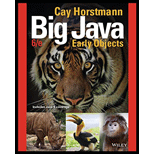
Big Java, Binder Ready Version: Early Objects
6th Edition
ISBN: 9781119056447
Author: Cay S. Horstmann
Publisher: WILEY
expand_more
expand_more
format_list_bulleted
Question
Chapter 20, Problem 2PP
Program Plan Intro
Statistical data set
Program plan:
DataSetFrame.java:
- Create a class named “DataSetFrame”. Inside the class,
- Define the required components.
- Set the width and height of the frame.
- Define the “DataSetFrame ()” method.
- Define the array list
- Initialize the labels
- Create a panel
- Add the component to the panel
- Set the frame size
- Define the “getAverage ()” method.
- Define the required variables.
- Loop that iterates for the data set values.
- Condition to compare the count values
- Define the method “getMinimum ()” and inside,
- Define the required variables.
- Loop that iterates for the data set values.
- Condition to compare the minimum values.
- Return the minimum values.
- Define the method “getMaximum ()” and inside,
- Define the required variables.
- Loop that iterates for the data set values.
- Condition to compare the maximum values.
- Return the maximum values.
- Define the method “createAddButton ()” and inside,
- Create a new button
- Define the class “createAddButton ()” and inside.
- Define the “actionPerformed ()” method
- Set the values
- Add the values
- Assign the values obtained
- Clear the text field.
- Define the action listener
- Add the button
- Return the value
- Define the “actionPerformed ()” method
DataSetViewer.java
- Create a class named “DataSetViewer”. Inside the class,
- Define the “main()” method
- Define the frame
- Set the close operation
- Set the visibility.
- Define the “main()” method
Expert Solution & Answer
Want to see the full answer?
Check out a sample textbook solution
Students have asked these similar questions
Dijkstra's Algorithm (part 1). Consider the network shown below, and Dijkstra’s link-state algorithm. Here, we are interested in computing the least cost path from node E (note: the start node here is E) to all other nodes using Dijkstra's algorithm. Using the algorithm statement used in the textbook and its visual representation, complete the "Step 0" row in the table below showing the link state algorithm’s execution by matching the table entries (i), (ii), (iii), and (iv) with their values. Write down your final [correct] answer, as you‘ll need it for the next question.
4. |z + 5 - 5i| = 7
14.
dz,
C: |z❘
C: |z❘ = 0.6
ze² - 2iz
H
Chapter 20 Solutions
Big Java, Binder Ready Version: Early Objects
Ch. 20.1 - Prob. 1SCCh. 20.1 - Prob. 2SCCh. 20.1 - Prob. 3SCCh. 20.1 - Prob. 4SCCh. 20.1 - Prob. 5SCCh. 20.1 - Prob. 6SCCh. 20.1 - Prob. 7SCCh. 20.1 - Prob. 8SCCh. 20.2 - Prob. 9SCCh. 20.2 - Prob. 10SC
Ch. 20.2 - Prob. 11SCCh. 20.2 - Prob. 12SCCh. 20.2 - Prob. 13SCCh. 20.3 - Prob. 14SCCh. 20.3 - Prob. 15SCCh. 20.3 - Prob. 16SCCh. 20.3 - Prob. 17SCCh. 20.3 - Prob. 18SCCh. 20.3 - Prob. 19SCCh. 20.4 - Prob. 20SCCh. 20.4 - Prob. 21SCCh. 20.4 - Prob. 22SCCh. 20.4 - Prob. 23SCCh. 20.4 - Prob. 24SCCh. 20.5 - Prob. 25SCCh. 20.5 - Prob. 26SCCh. 20 - Prob. 1RECh. 20 - Prob. 2RECh. 20 - Prob. 3RECh. 20 - Prob. 4RECh. 20 - Prob. 5RECh. 20 - Prob. 6RECh. 20 - Prob. 7RECh. 20 - Prob. 8RECh. 20 - Prob. 9RECh. 20 - Prob. 10RECh. 20 - Prob. 11RECh. 20 - Prob. 12RECh. 20 - Prob. 13RECh. 20 - Prob. 14RECh. 20 - Prob. 15RECh. 20 - Prob. 16RECh. 20 - Prob. 17RECh. 20 - Prob. 18RECh. 20 - Prob. 19RECh. 20 - Prob. 20RECh. 20 - Prob. 21RECh. 20 - Prob. 22RECh. 20 - Prob. 1PECh. 20 - Prob. 2PECh. 20 - Prob. 3PECh. 20 - Prob. 4PECh. 20 - Prob. 5PECh. 20 - Prob. 6PECh. 20 - Prob. 7PECh. 20 - Prob. 9PECh. 20 - Prob. 10PECh. 20 - Prob. 11PECh. 20 - Prob. 12PECh. 20 - Prob. 1PPCh. 20 - Prob. 2PPCh. 20 - Prob. 3PPCh. 20 - Prob. 4PPCh. 20 - Prob. 5PPCh. 20 - Prob. 6PPCh. 20 - Prob. 7PP
Knowledge Booster
Similar questions
arrow_back_ios
SEE MORE QUESTIONS
arrow_forward_ios
Recommended textbooks for you
 Database System ConceptsComputer ScienceISBN:9780078022159Author:Abraham Silberschatz Professor, Henry F. Korth, S. SudarshanPublisher:McGraw-Hill Education
Database System ConceptsComputer ScienceISBN:9780078022159Author:Abraham Silberschatz Professor, Henry F. Korth, S. SudarshanPublisher:McGraw-Hill Education Starting Out with Python (4th Edition)Computer ScienceISBN:9780134444321Author:Tony GaddisPublisher:PEARSON
Starting Out with Python (4th Edition)Computer ScienceISBN:9780134444321Author:Tony GaddisPublisher:PEARSON Digital Fundamentals (11th Edition)Computer ScienceISBN:9780132737968Author:Thomas L. FloydPublisher:PEARSON
Digital Fundamentals (11th Edition)Computer ScienceISBN:9780132737968Author:Thomas L. FloydPublisher:PEARSON C How to Program (8th Edition)Computer ScienceISBN:9780133976892Author:Paul J. Deitel, Harvey DeitelPublisher:PEARSON
C How to Program (8th Edition)Computer ScienceISBN:9780133976892Author:Paul J. Deitel, Harvey DeitelPublisher:PEARSON Database Systems: Design, Implementation, & Manag...Computer ScienceISBN:9781337627900Author:Carlos Coronel, Steven MorrisPublisher:Cengage Learning
Database Systems: Design, Implementation, & Manag...Computer ScienceISBN:9781337627900Author:Carlos Coronel, Steven MorrisPublisher:Cengage Learning Programmable Logic ControllersComputer ScienceISBN:9780073373843Author:Frank D. PetruzellaPublisher:McGraw-Hill Education
Programmable Logic ControllersComputer ScienceISBN:9780073373843Author:Frank D. PetruzellaPublisher:McGraw-Hill Education

Database System Concepts
Computer Science
ISBN:9780078022159
Author:Abraham Silberschatz Professor, Henry F. Korth, S. Sudarshan
Publisher:McGraw-Hill Education

Starting Out with Python (4th Edition)
Computer Science
ISBN:9780134444321
Author:Tony Gaddis
Publisher:PEARSON

Digital Fundamentals (11th Edition)
Computer Science
ISBN:9780132737968
Author:Thomas L. Floyd
Publisher:PEARSON

C How to Program (8th Edition)
Computer Science
ISBN:9780133976892
Author:Paul J. Deitel, Harvey Deitel
Publisher:PEARSON

Database Systems: Design, Implementation, & Manag...
Computer Science
ISBN:9781337627900
Author:Carlos Coronel, Steven Morris
Publisher:Cengage Learning

Programmable Logic Controllers
Computer Science
ISBN:9780073373843
Author:Frank D. Petruzella
Publisher:McGraw-Hill Education